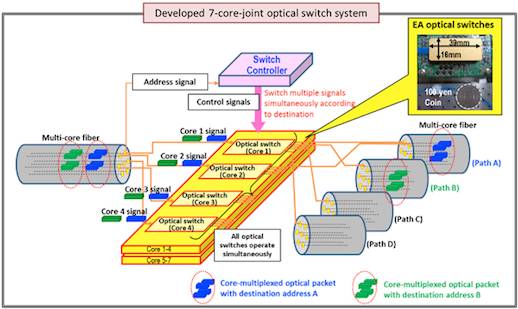This article is more than 1 year old
Boffins' bonkers fibre demo: 53 Tbps down ONE piece of glass
Japan's NICT looks to data centres of the future
If you've always wanted to pump more than 50 Tbps down a data centre fibre, good news: it can be done. The bad news is that right now, it needs a fair whack of boffinry and equipment.
Japan's National Institute of Information and Communications Technology has laid claim to a four-fold increase over previous fibre transport records, hitting 53.3 Tbps using multi-core fibres to provide spatial multiplexing inside the glass.
To this, according to NICT, also needed a switch able to switch all seven cores of a fibre, simultaneously, with a switching speed of 80 nanoseconds.
For the test, the NICT boffins used three different fibre segments: a 28 km segment that had 19 cores available; a 10 km segment, also with 19 cores; and a 2km fibre with seven cores.
“This testbed used 64 wavelength channels, modulated at 32 Giga Baud with polarization division multiplexing (PDM) quadrature phase shift keying (QPSK). This delivers a nominal capacity of 53.3 Tbps,” the NICT announcement explains.
As the boffins' illustration below shows, addressing is pulled from the incoming signal and passed to the switch controller.

The researchers (José Manuel Delgado Mendinueta, Satoshi Shinada, Ruben Luís, Yusuke Hirota, Hideaki Furukawa, Hiroaki Harai and Naoya Wada) add that the high capacity of their system also reduces power consumption per bit, an important consideration in data centres.
The researchers published their experiment as a post-deadline paper in late September's European Conference on Optical Communication in Gothenburg, Sweden. ®
